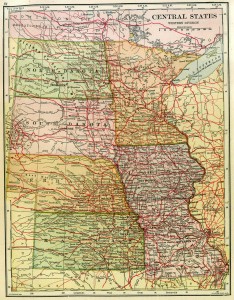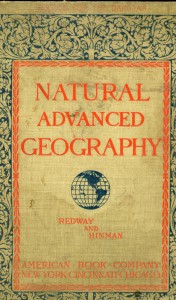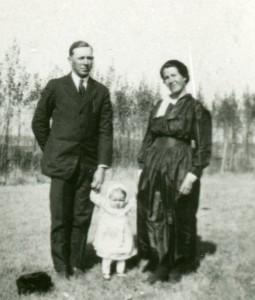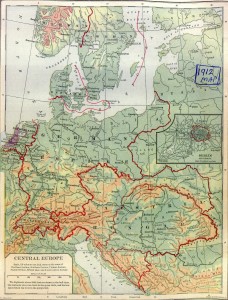#1078 – Dick Bernard: North Dakota and South Dakota in 1912. A school textbook freezes a year in time.
Today, November 1, 2015, is the 365th day of North and South Dakota’s 125th anniversary as states of the U.S. Tomorrow they’re 126 – that’s a bit like having been 21, and now you’re 22. It seems a good day to remember a bit more of that good year, the 125th….
(click to enlarge all photos)
As readers of this blog know, the past year has found me frequently and physically revisiting the rural North Dakota where Mom, born 1909, grew up. Soon the 110-year family farm, not far from LaMoure, will belong to new owners. The work has been hard, both physical and emotional, now close to finished. Three times in the last twelve months I’ve written about the 125th birthday of ND: Sep 17, 2014, Oct 1, 2014 and Nov 2, 2014.
October 18,2015, I was at the farm, doing a near-final “sift” of “junk” left in the machine shed, and an old book caught my eye. I fished it out of a box. A portion of the 10×12″ cover is pictured below (click to enlarge).
I’m an old geography major. Back home I decided to leaf through and see what I’d find. Its last copyright was 1912.
At the very end of the book, I found two chapters on North Dakota and South Dakota geography.
(Not until preparing this post on October 29 did I notice the note at the very top of the cover page of the book. You can see it hidden, above, at the top of the page. Apparently there were many regional editions of this more than 175 page textbook, each having a section focused on a particular state or region of the U.S.)
What the book had to say about North and South Dakota geography is presented in entirety here (in two twelve page chapters): No. Dak Geog 1912002 (including 23 photos) and So. Dak Geog 1912003 (27 photos).
At page 77, North and South Dakota are introduced:
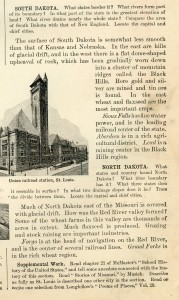
The chapters have lots of most interesting tidbits.
On the last page of each state chapter is its 1910 census.
For North Dakota the 1910 census total was 577,056. The “Principal Cities” ranged from Fargo (14,331) to Eckman (population 84, founded 1908, not long after almost a ghost town near Maxbass.). South Dakota totaled 583,888 including Sioux Falls (14,094) and Effington (46) among the “Principal Cities”.
(North Dakota’s current population is 714,551 est in 2013; South Dakota’s 833,354. In 1960, when I was in college, the respective populations were 630,000 (ND) and 680,000 (SD)
1910 was North and South Dakota’s 21st birthday, each state roaring along with all the enthusiasm and hope of someone at 21.
For reasons most of we natives of the states have learned, boom times ebbed, and things like the Great Depression of the 1930s left their mark, everywhere. As my relative, Melvin, born 1928, who grew up the next farm over, said in a letter just days ago: “It was a good life for all of us and I am sure that there will always be some bitter sweet memories of the old homesteads, growing up in the Post Depression years which were further dampened by the drought, grass hoppers and the dust bowl in the prewar [WWII] years.”
The chapters, and the book itself, are filled with raw material for great conversations. (If interested, note that the 1898 edition, probably for the California market, is at google books (click on the tab, other formats).
POSTNOTE: Geography is much more than just relatively static features, like rivers and mountains. It is very much geopolitical: things as country and state names, and boundaries, and peoples, and conflict change the picture of the landscape. So the publication date of a map or data on which text is based makes a big difference.
For a single example, note the below map of Central Europe in the 1912 textbook. The configuration of the countries is much different in 1912 than it is today, and played into World War I, then into World War II.
If you live in the Minneapolis-St. Paul area, there is a current and important exhibition at the Museum of Russian Art entitled “Faces of War: Russia in World War I (1914-18)”. We have been to this exhibit, and the text and pictures are a vivid history lesson in themselves. Do take the time if you haven’t already done so. The Museum is at 5500 Stevens Avenue S. Minneapolis, at the west edge of I-35W, at the SW corner of Stevens Avenue S and Diamond Lake Road.

